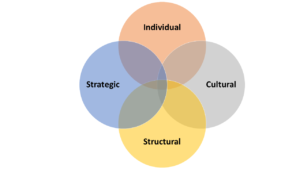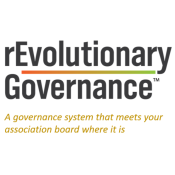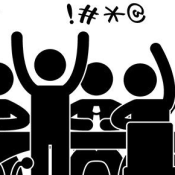
How to Spot the Top Indicators of Board of Directors’ Dysfunction
In my last post, How Healthy is Your Board?, I discussed the four domains that drive how board members show up and contribute given the cultural, structural, individual and strategic orientation of an association.
If your goal is to help your board move from one that is dysfunctional (think member conflict or disengagement) to transformational, you need to first step back and look at it holistically. This allows you to spot all the indicators in each of the four domains that are contributing to your board’s dysfunction.
The four domains of board functioning include:
- Individual
- Cultural
- Structural, and
- Strategic

The four-domain framework essentially provides a balanced scorecard approach to board evaluation. Although the domains are presented as four discrete areas, in reality, they aren’t. They might be more appropriately represented as a Venn diagram or matrix; they’re interwoven. The usefulness of separating them into separate domains is in diagnosing the root cause of suboptimal functioning.
In each of the four domains, there are inhibitors and enhancers to effective board functioning. Let’s take a closer look at each of the four domains, what health in that domain looks like, and some examples of key ailments.
In a more acute phase of the disease, board members engage in fights (verbal – or worse, physical), board members and staff start quitting, and the board begins striving for mediocrity…
Jeff Arnold
President, Leading Associations
Cultural
In the Cultural domain, signs of board health include:
- Decisiveness: The board is effective at thoughtful deliberation, engaging in productive dialog, then arriving at a consensus decision – quickly.
- Deliberation: The board does its homework. Decisions are made based on data vs. opinions and made only after thoughtfully examining the issue.
- Engagement: Discussions are balanced, not dominated by a few outspoken individuals while others remain passively disengaged. Board members really show up, not just physically, but mentally and emotionally.
- Unity: Even if there is dissent during deliberations, board members are not only able to unite behind the ultimate outcome, but be an advocate for it. When heated discussions occur, board members attack the issues but not each other.
- Trust: Regardless of where people stand on the issues, they ultimately trust that everyone has the best interest of the organization in mind. Board members assume positive motives among their peers and have each other’s backs. The board is able to delegate authority and responsibility to staff and committees without second-guessing or micromanaging.
A key example of a Cultural domain ailment is Factionitis/Divided Board Syndrome. The chronic symptoms of this disease are a total inability to govern, a loss of organizational focus, and board members dreading attending the meetings. Boards members might say to themselves, “If we could just have one board meeting without an ugly fight, that would be awesome!” Key signs the disease has become a critical illness are when Lawyers, accountants, and/or PR firms (to do damage control) are hired. Other signs of critical illness are member fights, an election coup d’état, or the formation of splinter organizations.




